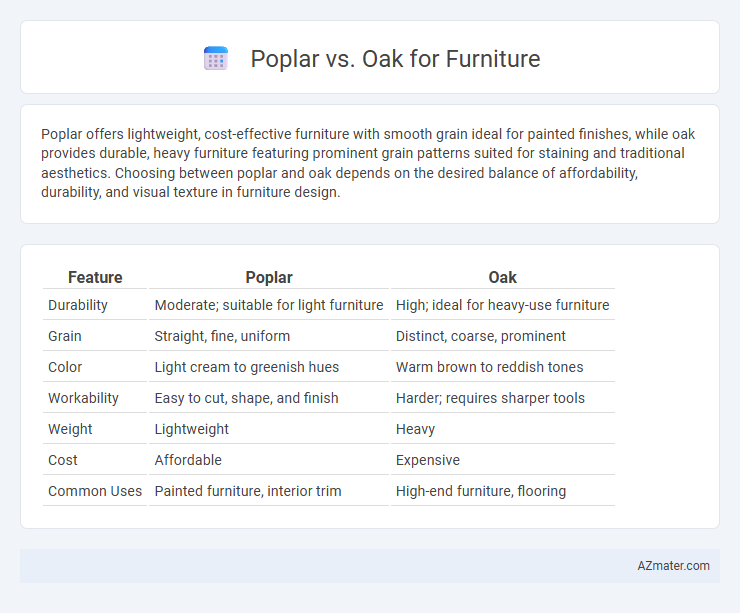Poplar offers lightweight, cost-effective furniture with smooth grain ideal for painted finishes, while oak provides durable, heavy furniture featuring prominent grain patterns suited for staining and traditional aesthetics. Choosing between poplar and oak depends on the desired balance of affordability, durability, and visual texture in furniture design.
Table of Comparison
| Feature | Poplar | Oak |
|---|---|---|
| Durability | Moderate; suitable for light furniture | High; ideal for heavy-use furniture |
| Grain | Straight, fine, uniform | Distinct, coarse, prominent |
| Color | Light cream to greenish hues | Warm brown to reddish tones |
| Workability | Easy to cut, shape, and finish | Harder; requires sharper tools |
| Weight | Lightweight | Heavy |
| Cost | Affordable | Expensive |
| Common Uses | Painted furniture, interior trim | High-end furniture, flooring |
Introduction to Poplar and Oak in Furniture Making
Poplar and oak are two popular hardwood choices in furniture making, valued for their unique properties and aesthetics. Poplar is a lightweight, affordable wood with a fine, even grain, making it easy to work with and ideal for painted or stained finishes. Oak, known for its durability and pronounced grain pattern, is often selected for high-quality, heavy-use furniture pieces requiring strength and long-lasting appeal.
Key Characteristics of Poplar Wood
Poplar wood is lightweight, with a fine, even texture and a pale cream to greenish hue, making it easy to paint and stain for versatile furniture design. It features moderate hardness and good machinability, providing durability while remaining more affordable compared to oak. Poplar's resistance to warping and smooth finish make it ideal for indoor furniture that requires a balance of strength and aesthetic customization.
Key Characteristics of Oak Wood
Oak wood is renowned for its exceptional durability, prominent grain patterns, and resistance to wear, making it ideal for high-quality furniture. Its dense hardwood structure offers superior strength and stability compared to softer woods like poplar. Oak's natural resistance to dents and scratches ensures longevity, while its warm, rich tones enhance the aesthetic appeal of furniture pieces.
Appearance and Grain Comparison
Poplar wood features a light, creamy color with subtle green or brown streaks, offering a smooth and uniform grain that provides a sleek, modern aesthetic ideal for painted or stained finishes. Oak exhibits a prominent, coarse grain pattern with rich, warm tones ranging from light to medium brown, contributing to a classic, rustic appearance prized for natural or stained furniture pieces. The distinct grain visibility in oak enhances texture and character, whereas poplar's finer grain yields a more understated, versatile look suitable for contemporary designs.
Durability and Strength: Poplar vs Oak
Oak furniture is renowned for its superior durability and strength, featuring a dense grain that resists dents and scratches, making it ideal for high-traffic or heavy-use pieces. Poplar, while softer and less dense than oak, offers moderate strength suitable for lightweight or decorative furniture but may show wear more quickly over time. Choosing oak ensures long-lasting sturdiness and resilience, whereas poplar suits budget-conscious projects where extreme durability is not essential.
Workability and Ease of Use
Poplar is highly favored for furniture workability due to its soft texture, making it easier to cut, shape, and sand compared to oak, which is much harder and denser. Oak's hardness and grain complexity require sharper tools and more effort, but it provides exceptional durability and a sturdy finish. For carving and detailed craftsmanship, poplar's smooth, even grain reduces tool wear and allows faster production, while oak demands more skill and time, impacting ease of use.
Cost Comparison: Poplar vs Oak
Poplar furniture is significantly more affordable than oak, with prices often averaging 30-50% lower due to its faster growth rate and abundance. Oak's higher cost reflects its durability, hardness, and fine grain, making it a premium choice for long-lasting, high-quality furniture. Choosing poplar offers budget-friendly options without sacrificing workability, while oak commands a higher investment for superior strength and aesthetic appeal.
Staining, Finishing, and Maintenance
Poplar wood absorbs stain unevenly, often resulting in blotchy finishes that require pre-treatment or gel stains for a more consistent appearance, while oak's open grain pattern stains evenly, producing rich and vibrant colors. Oak furniture benefits from a durable finish that enhances its natural grain and resists wear, whereas poplar typically requires multiple coats of finish to protect its softer surface from dents and scratches. Maintenance of oak furniture is generally easier due to its hardness and resistance to moisture, making it less prone to damage over time compared to the more delicate and easily marred poplar.
Best Furniture Applications for Poplar and Oak
Poplar is ideal for painted furniture, children's furniture, and budget-friendly pieces due to its smooth grain and lightweight properties. Oak excels in high-end furniture, flooring, and cabinetry, valued for its strength, durability, and distinctive grain patterns. Both woods offer unique benefits; poplar suits projects requiring easy finishing, while oak is preferred for long-lasting, visually striking furniture.
Conclusion: Choosing the Right Wood for Your Furniture
Poplar offers affordability, lightweight durability, and smooth grain, making it ideal for painted furniture and intricate designs, while oak boasts exceptional strength, prominent grain, and natural resistance to wear, suited for heavy-use and traditional styles. Selecting oak ensures long-lasting, visually striking pieces, whereas poplar provides versatility and budget-friendly options without compromising quality. Your choice should reflect the desired furniture function, aesthetic preference, and maintenance considerations to balance cost and longevity effectively.

Infographic: Poplar vs Oak for Furniture
 azmater.com
azmater.com